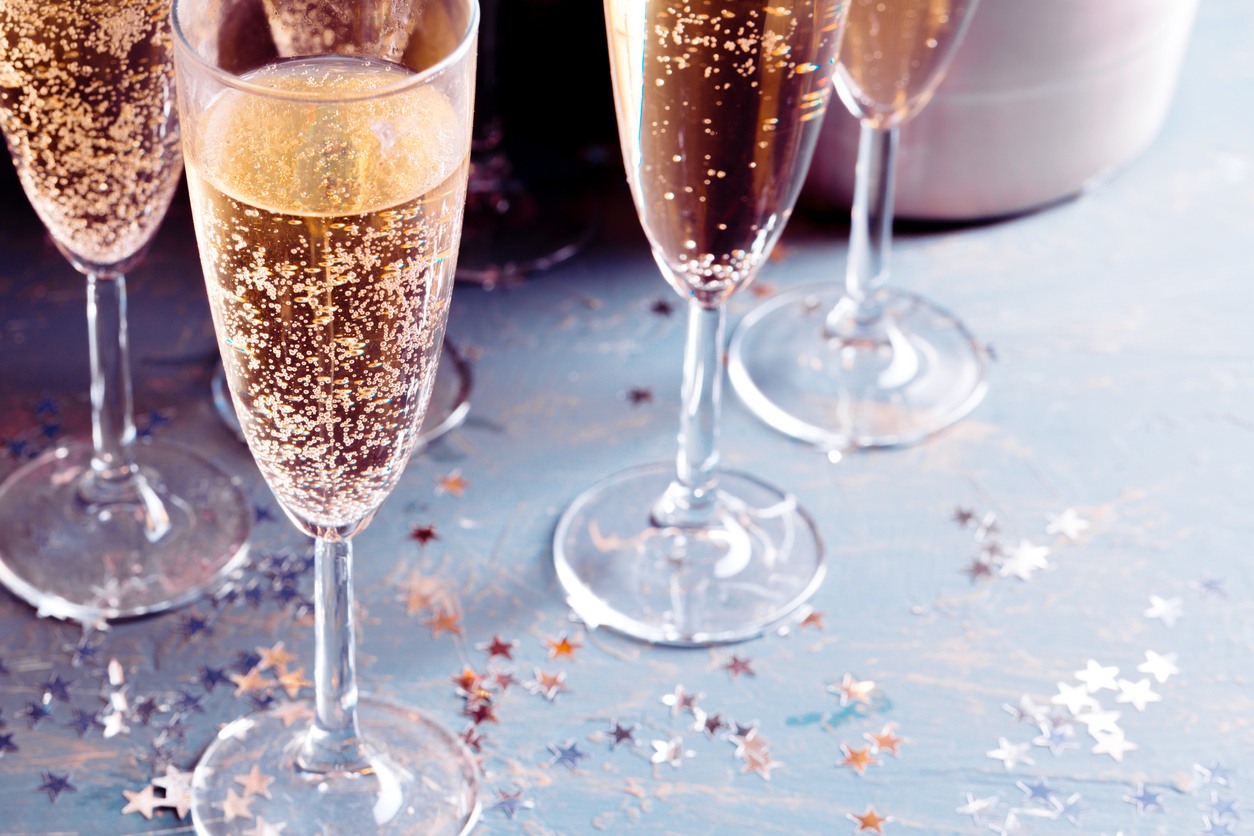*Sale takes place from December 26-31 2024 at all four Sonoma County Oliver’s Market locations.
“Bonne Année!” “Feliz Año Nuevo! “Godt Nyttår!” No matter what language you say it in, “Happy New Year” sounds even sweeter with the distinct “POP” of bubbly being opened in the background. For eons, humans have naturally associated sparkling wines with celebration, and you only need try one to understand why –nothing captures the joy of good company and good food quite like a sparkling wine. Their bright effervescence lends a bubbling airiness that’s impossible to replicate and is infectious in its joviality. We associate sparkling wines like Champagne and Prosecco with holidays and other happy occasions because that is how they make us feel: happy!
The most easily recognized types of sparkling wine are French Champagne and Italian Prosecco, but those are actually region-specific wines and technically (with a few exceptions) can’t be made outside those regions. Sparkling wines can be grouped based on region, production method, and style, but it’s not as complicated as it sounds.
Let’s get the basics of Sparkling Wine covered here.
Producing Countries
Sparkling wines can be made in any wine producing region, but most of the sparkling wines we feature come from California, Italy, France, and Spain.
Production Methods
There are three primary methods used to produce sparkling wine: methode champenoise , ancestrale, and Charmat. All three methods start with high-acid, still base wine, and all three involve the addition of yeast and sugar to jumpstart fermentation and the formation of bubbles. From there, they diverge in three directions. Wines made using méthode champenoise will continue to age in their bottle until the yeasts fermenting them die off completely; at this point, they are kept at a sharp angle and regularly turned (called riddling) to move the dead yeast into the neck of the bottle. Finally, the yeast is disgorged (read: fired out of the bottle like a tiny cannon ball) and a small amount of sugar is added to the bottle before it’s corked, known as dosage. At the same time, in the less common méthode ancestrale, wine is fermented first in barrels and then in bottles, requiring very specific timing on the part of the winemaker. The goal is to preserve enough sugar and live yeasts that the wine is able to finish fermenting in the bottle but not so much that the bottle actually explodes; this method is the oldest of the three, and only a handful of sparkling wines are still produced this way today. Finally, the Charmat, or Bulk, is the newest of the three methods: wines are aged in a steel tank with sugars and yeast, which are eventually filtered out of the final product. This allows for large scale production of fresh-tasting, fruit-forward wines like Prosecco or less expensive domestic sparkling wines. The bubbles in these wines are typically larger than those made in the methode champenoise.
If you are curious, you can usually find the method of production noted somewhere on the label. You will find that finer wines are generally produced using methode champenoise, while wines made using the Bulk or Charmat method tend to be less expensive and designed for casual enjoyment.
Sparkling Styles
These methods are used to produce a range of different sparkling wines, each with their own unique character and flavor profiles. Because sparkling wines are usually made using a blend of different grape varietals, they’re not categorized using the same standards as still wine. Instead, they’re categorized based on where they come from, the style they were made in, and how they taste. From dry to sweet, the categories used fairly universally are as follows:
- Brut Nature – The driest of the categories, 3 grams of sugar or less per liter of wine.
- Extra Brut – Slightly more added sugar than Brut Nature, but still quite dry. 6 grams of sugar per liter.
- Brut – Edging towards the middle, still dry but more added sugar than Brut Nature or Extra Brut. 12 grams of sugar per liter.
- Extra Dry – True middle. Off-dry, but not sweet. 17 grams of sugar per liter.
- Dry – Also off-dry. 32 grams of sugar per liter.
- Demi-Sec – Sweet, with a decent amount of added sugar. 50 grams of sugar per liter.
- Doux – Very sweet. 100 grams of sugar per liter.
Remember the dosage we mentioned earlier? Sparkling wine is naturally very acidic, and as a result, the flavor can be quite tart and sour. To combat this, a small amount of sugar is added to mellow the flavors of the wine. How much or how little is added results in the final classification of the wine. These categories aren’t restricted to just French bubbly as well – American, Italian, Spanish, and Portuguese wineries all use these categories to differentiate between their sparkling wines.
Knowing even a little bit about how your wine is made and categorized can go a really long way towards picking out the right sparkling wine for you. It is also important to remember that the subtleties of a fine sparkling wine saved for a special occasion would be lost in a Mimosa. Different sparkling wines suit different needs.
Up Your Sparkle!
OK, so you know to chill a bottle of bubbles to pop for a special moment or occasion, but where else do sparkling wines work in a wine lover’s lifestyle?
With appetizers: before jumping into red and white wines, start your next dinner party with sparkling wines to add a festive note. As a bonus, sparkling wines generally pair well with fried or salty foods, making most appetizers and easy match.
With Take-Out: Sushi and sparkling wines are a natural match, and an off-dry sparkling wine can take the heat from Chinese or Indian cuisine easily.
In a Cocktail: Check out these simple but very elegant cocktail recipes and see sparkling wine’s potential far beyond the basic Mimosa. How about a Chambord Kir Royale, or a Classic Champagne Cocktail? Or perhaps an Elderflower French 75 Cocktail or a Prosecco Cocktail is what you need? Add fruit and create a Prosecco Bellini or a Strawberry Rossini. So many wonderful possibilities here!
Sparkling Staff Assistance
Don’t forget to ask our knowledgeable Wine Department staff for recommendations based on your occasion and budget. They are standing by, ready to assist!
This is your week, sparkling wine fans: Go forth and score some savings as you bring in the New Year! Cheers!


No comments yet. Add the first comment